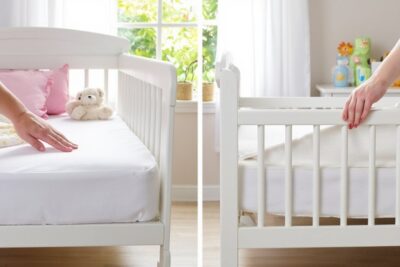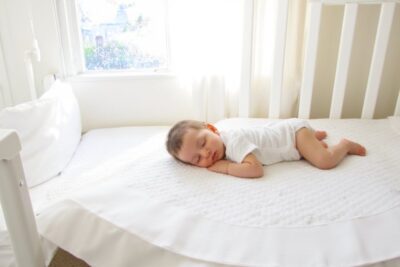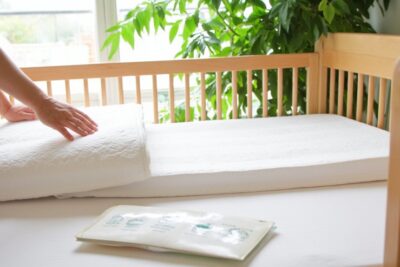
Is a Memory Foam Crib Mattress Safe?

You shouldn't use a memory foam crib mattress for your baby because it’s generally too soft and increases risks of suffocation and SIDS. Experts recommend firm mattresses that support proper spinal alignment and ventilation. Many memory foam mattresses also emit harmful chemicals like VOCs, which can affect your infant’s health. If you want a safe sleep environment, look for certified firm mattresses with breathable, non-toxic covers. Keep exploring to understand how to choose the safest option for your child.
- Main Points
- Understanding Memory Foam in Crib Mattresses
- Safety Standards for Crib Mattresses
- Importance of Mattress Firmness for Infants
- Chemical Emissions and Certifications to Look For
- Risks of Volatile Organic Compounds (VOCs) in Foam Mattresses
- Flame Retardants and Their Impact on Health
- Comparing Memory Foam to Other Crib Mattress Materials
- Proper Mattress Fit and Size Requirements
- The Role of Waterproof and Breathable Mattress Covers
- Recommendations From Pediatric and Safety Organizations
- Tips for Selecting a Safe Memory Foam Crib Mattress
- Frequently Asked Questions
- Final Thoughts
Main Points
- Memory foam crib mattresses are generally unsafe due to their softness, increasing suffocation and SIDS risks for infants.
- Most memory foam mattresses fail to meet the firm mattress standards recommended by the American Academy of Pediatrics.
- Look for GREENGUARD Gold and CertiPUR-US certifications to ensure low chemical emissions and safer mattress options.
- Memory foam can emit VOCs harmful to infants' respiratory health; organic materials help reduce chemical exposure.
- Firm, breathable mattresses with vinyl-free covers are safer, promoting proper spinal support and reducing overheating risks.
Understanding Memory Foam in Crib Mattresses
Although memory foam is popular for adult mattresses, it poses significant safety concerns when used in crib mattresses. Memory foam mattresses conform to an infant’s weight, creating a soft surface that increases the risk of suffocation and Sudden Infant Death Syndrome (SIDS). Additionally, many memory foam crib mattresses are made from polyurethane foam that can emit volatile organic compounds (VOCs), which may harm infants’ developing bodies. The softness also disrupts proper spinal alignment, potentially causing discomfort and developmental issues. Importantly, most memory foam crib mattresses don’t meet the firmness safety standards recommended by the American Academy of Pediatrics (AAP). Mattresses with high-density foam cores provide a safer, firmer surface that helps reduce suffocation risk and maintain comfort over time. To protect infants, you should choose a firm mattress that offers solid support and reduces suffocation risk, steering clear of memory foam options altogether. Prioritizing safety helps you serve your child’s well-being effectively.
Safety Standards for Crib Mattresses

You need to choose a memory foam crib mattress that meets strict certifications and regulations to guarantee your baby’s safety.
Pay close attention to firmness and fit, as these factors directly reduce risks like SIDS and suffocation.
Also, look for low chemical emissions certified by labels such as Greenguard Gold to protect your infant from harmful substances.
For added peace of mind, consider crib mattresses that are GREENGUARD Gold certified for low chemical emissions, as this certification ensures a healthier sleep environment for your child.
Certification and Regulations
When selecting a memory foam crib mattress, understanding the certification and regulatory standards is critical for your baby’s safety.
You should look for certifications that confirm compliance with safety regulations set by the Consumer Product Safety Commission (CPSC), which guarantees mattresses meet strict requirements for flammability and harmful substances.
Certifications like Greenguard Gold and CertiPUR-US verify low chemical emissions and the absence of toxic chemicals, making them safer choices for infants.
Additionally, organic certifications such as the Global Organic Textile Standard (GOTS) indicate that most materials are produced organically, further reducing exposure to harmful compounds.
Being informed about these certifications empowers you to choose a crib mattress that prioritizes your baby’s health and provides a safe, non-toxic sleep environment.
Firmness and Fit
Since mattress firmness directly impacts infant safety, choosing a crib mattress that meets strict firmness standards is essential.
Soft surfaces increase the risk of Sudden Infant Death Syndrome (SIDS), so crib mattresses must be firm enough to avoid conforming to your baby’s body. Mattresses made with dual-sided firmness options can extend usability from infancy through toddlerhood while maintaining safety standards.
To comply with safety guidelines and CPSC standards, guarantee the mattress fits snugly within the crib frame, with no gaps larger than ½ inch.
Standard dimensions—about 27¼ by 51¼ inches and no thicker than 6 inches—help maintain this snug fit, preventing suffocation hazards.
Regularly check the mattress height as your child grows to maintain mattress safety and prevent falls.
Prioritizing firmness and proper fit supports a secure sleep environment that protects your infant effectively.
Chemical Emissions Limits
Anyone selecting a crib mattress should prioritize chemical emissions limits to guarantee infant safety.
The Consumer Product Safety Commission (CPSC) enforces strict regulations on chemical emissions, including volatile organic compounds (VOCs), which can be harmful to babies. Mattresses with GREENGUARD Gold certification have been tested for low emissions, giving parents confidence in their baby’s sleep environment.
Foam mattresses, especially those containing polyurethane, often release VOCs, raising concerns.
To minimize risks, choose mattresses with GREENGUARD Gold certification, which assures low chemical emissions and better indoor air quality.
Additionally, look for organic certifications like GOTS that require a high percentage of organic materials free from toxic chemicals.
These standards help you serve infants by providing a safer sleep environment, reducing exposure to harmful substances, and meeting rigorous safety benchmarks established by trusted organizations.
Prioritizing these certifications protects your baby’s health effectively.
Importance of Mattress Firmness for Infants

You need to choose a firm mattress to keep your baby safe and healthy, as soft surfaces increase the risk of suffocation and SIDS.
The American Academy of Pediatrics stresses that a firm, flat mattress supports proper spinal alignment and reduces hazards.
Firmness and Safety
Although soft mattresses might seem more comfortable, they pose significant risks for infants by increasing the chance of suffocation and Sudden Infant Death Syndrome (SIDS).
You need to choose a firm mattress that meets strict safety features to protect your baby. The American Academy of Pediatrics (AAP) strongly recommends a firm sleep surface to guarantee proper spine alignment and prevent your infant from sinking into the mattress. For added assurance, consider mattresses with GREENGUARD Gold certification to ensure low chemical emissions and adherence to rigorous safety standards.
Soft mattresses, including many memory foam options, conform too much to your baby's body, blocking airways and raising SIDS risk. A firm crib mattress also enhances ventilation and breathability, creating a breathable crib environment that reduces overheating hazards.
Prioritizing firmness is essential for your infant’s safe sleep and peace of mind.
Impact on Infant Health
When infants sleep on a firm mattress, they benefit from proper spinal alignment and a considerably reduced risk of suffocation and Sudden Infant Death Syndrome (SIDS). The American Academy of Pediatrics emphasizes that a firm mattress in the crib is crucial for infant health, warning against soft surfaces that increase risks of suffocation and carbon dioxide rebreathing. Memory foam crib mattresses, which conform to a baby's weight, often compromise firmness and safety. Many crib mattresses, such as those with dual-sided designs for infants and toddlers, are specifically engineered to meet safety standards by offering a firm surface for infants while providing comfort as they grow. Research confirms that babies on firm surfaces are less likely to roll into hazardous positions, enhancing safety. To protect infants, select a crib mattress that meets the Consumer Product Safety Commission’s firmness standards. Prioritizing a firm mattress supports safe sleep environments and greatly contributes to reducing SIDS risk, ensuring the well-being of the infant under your care.
Chemical Emissions and Certifications to Look For

Since memory foam crib mattresses can release volatile organic compounds (VOCs) linked to respiratory problems, it's essential to prioritize chemical emissions when choosing one.
You should look for mattresses certified by GREENGUARD Gold, which guarantees low chemical emissions and supports healthier indoor air quality for your baby. Some crib mattresses, like the Newton Baby Crib Mattress, are made with eco-friendly, GREENGUARD GOLD certified materials to minimize harmful chemical exposure and improve indoor air quality.
Additionally, the MADE SAFE certification offers reassurance by screening out over 6,500 harmful substances.
Organic certifications, like GOTS, ensure that a significant portion of the mattress fibers are organic, minimizing exposure to chemicals.
Avoid mattresses containing toxic flame retardants and PVC, as these can compromise safety and air quality.
By selecting products with these certifications, you actively protect your infant’s health and create a safer sleep environment free from harmful chemical emissions.
Risks of Volatile Organic Compounds (VOCs) in Foam Mattresses

You should know that memory foam crib mattresses can release volatile organic compounds (VOCs), which include harmful chemicals like phthalates and formaldehyde.
These emissions can disrupt hormone systems and cause respiratory issues, especially in babies who breathe more air relative to their size.
Understanding how VOC exposure affects indoor air quality is essential for protecting your child's health.
VOC Emissions Explained
How do volatile organic compounds (VOCs) in memory foam crib mattresses impact your baby's health?
VOC emissions from memory foam mattresses release harmful chemicals like phthalates and formaldehyde, which carry significant health risks.
Babies are especially vulnerable due to their developing respiratory systems and extended time spent in cribs.
These compounds can accumulate in nursery air, increasing exposure and potential respiratory issues.
To protect your baby, consider these points:
- VOCs can disrupt hormone systems and lead to health complications
- Memory foam mattresses often emit higher VOC levels than natural materials
- Enclosed nursery spaces intensify VOC concentration
- Choosing low-VOC or natural-material mattresses reduces chemical exposure
- Awareness of VOC emissions helps you make safer crib mattress choices
Prioritizing low-emission options supports your baby’s health and well-being effectively.
Health Impacts Exposure
Understanding the presence of volatile organic compounds (VOCs) in memory foam crib mattresses is only part of the story; grasping their health impacts is equally important.
VOCs released from polyurethane foam and adhesives introduce harmful chemicals into your baby’s sleep environment. Babies need protection because their developing bodies and rapid breathing rates make them especially vulnerable to these toxins. Choosing a crib mattress that is GREENGUARD Gold certified can help ensure lower chemical emissions and a safer sleep space.
Studies link VOC exposure to respiratory issues, hormonal disruptions, and developmental problems. Choosing a mattress containing VOCs risks long-term health impacts that no caregiver should accept.
To provide the safest sleep environment, opt for mattresses made from organic materials like cotton, wool, or natural latex, which minimize harmful chemical emissions. Serving your child means prioritizing materials that support healthy development and reduce exposure to dangerous VOCs.
Flame Retardants and Their Impact on Health
Although flame retardants are widely used in memory foam crib mattresses to meet safety standards, they can release harmful chemicals like PBDEs that pose significant health risks.
These toxic substances accumulate in the body, especially affecting infants who are most vulnerable to toxic exposure.
As someone who cares deeply about infant safety, you should know:
- Flame retardants may disrupt hormones and increase cancer risk.
- Harmful chemicals can build up in breast milk and tissues.
- Some states ban certain flame retardants due to health concerns.
- Natural materials like wool offer safer flame resistance.
- Manufacturers often don’t fully disclose flame retardant use.
Choosing mattresses with natural materials can reduce health risks while ensuring safety for your little one’s environment.
Stay informed and prioritize non-toxic options.
Comparing Memory Foam to Other Crib Mattress Materials
Why might memory foam crib mattresses be less safe compared to other materials? Memory foam tends to conform to your baby’s weight, creating a sinking effect that increases suffocation risks. The American Academy of Pediatrics recommends firmer options, like foam or innerspring crib mattresses, which provide a flat, supportive surface essential for safe sleep and spinal alignment. Memory foam often contains polyurethane and can emit volatile organic compounds (VOCs), potentially affecting indoor air quality. In addition, crib mattresses with GREENGUARD Gold certification are verified to meet rigorous chemical emissions standards and are considered safer for your baby’s environment. In contrast, crib mattresses made from organic materials such as natural latex and organic cotton offer safer materials free from harmful chemicals. These options typically have certifications like Greenguard Gold, ensuring low chemical emissions and better breathability. Choosing firmer, safer materials over memory foam greatly reduces risks and promotes a healthier sleep environment for your baby.
Proper Mattress Fit and Size Requirements
Choosing the right mattress material plays a significant role in your baby’s safety, but guaranteeing the mattress fits properly in the crib is just as important.
Proper fit minimizes safety risks like suffocation hazards by preventing gaps between the mattress and crib perimeter. When selecting crib mattresses, keep these essential points in mind:
- Mattress dimensions should be at least 27¼ inches wide and 51¼ inches long.
- Thickness mustn't exceed 6 inches to avoid increased risk.
- Firmness is critical; the mattress should be firm and not conform to your baby’s weight.
- Guarantee no more than a ½-inch gap exists between mattress edges and crib perimeter.
- Regularly inspect the mattress fit as your baby grows to maintain secure placement.
- When considering overall nursery safety, side impact protection is a key feature in some of the safest car seats and highlights the importance of sturdy crib construction and a snug-fitting mattress.
Following these guidelines safeguards your child and supports safe sleep environments.
Recommendations From Pediatric and Safety Organizations
Although memory foam mattresses offer comfort for adults, pediatric and safety organizations strongly advise against their use for infants.
The American Academy of Pediatrics (AAP) emphasizes that crib mattresses must be firm enough to guarantee safe sleep and reduce SIDS risk.
The Consumer Product Safety Commission (CPSC) also mandates a snug mattress fit without gaps, which memory foam may not reliably provide.
Additionally, memory foam can trap heat, increasing overheating risks, and emit volatile organic compounds (VOCs) harmful to infants’ developing lungs.
Key recommendations include:
- Use firm, flat crib mattresses as per AAP guidelines
- Ensure mattresses fit snugly to prevent gaps (CPSC)
- Avoid materials that retain heat, increasing SIDS risk
- Steer clear of mattresses emitting VOCs
- Prioritize crib mattresses meeting established safety standards
Following these guarantees you protect infant health and promote safe sleep.
Tips for Selecting a Safe Memory Foam Crib Mattress
To select a safe memory foam crib mattress, start by verifying certifications like CertiPUR-US that guarantee the product is free from harmful chemicals such as formaldehyde and heavy metals.
Verify certifications like CertiPUR-US to ensure the memory foam crib mattress is free from harmful chemicals.
Choose a firm memory foam crib mattress to support proper spinal alignment and reduce suffocation risks.
Prioritize mattresses made from natural materials or certified organic foams, as they emit fewer volatile organic compounds (VOCs), promoting healthier air quality.
Ascertain the mattress fits snugly within the crib, leaving no gaps larger than two fingers to prevent entrapment hazards.
Additionally, opt for breathable designs that enhance airflow, preventing overheating during sleep.
By focusing on these factors, you’ll provide a safe, comfortable sleeping environment that protects your baby’s well-being and supports your caregiving mission.
Frequently Asked Questions
Are Memory Foam Crib Mattresses Safe?
You shouldn’t rely on memory foam crib mattresses since they often fail safety standards for firmness, breathability, and chemical exposure. Parent reviews highlight durability concerns and limited hypoallergenic properties, making firmer, tested alternatives a safer choice for your baby.
Is It Okay for Babies to Sleep on Memory Foam Mattresses?
You shouldn’t use memory foam for babies due to safety concerns like improper sleep position, inadequate firmness, poor temperature regulation, allergy issues, and longevity factors. It often fails regulatory standards essential for infant sleep safety.
Is a Memory Foam Mattress Ok for Children?
You might appreciate memory foam benefits like temperature regulation and hypoallergenic materials, but for child sleep safety, mattress firmness matters more. Durability concerns arise, so consider alternative options offering firmer, safer surfaces for your child's healthy rest.
Why Are People No Longer Buying Memory Foam?
You’re seeing market trends shift because memory foam alternatives offer better firmness levels, improved breathability, and temperature regulation. Safety concerns and chemical exposure risks with memory foam drive parents to choose healthier, safer options for their children.
Final Thoughts
You want a memory foam crib mattress that meets safety standards, offers firm support, and fits snugly in the crib. You should choose one with low chemical emissions and proper certifications to protect your baby’s health. You need a mattress that’s breathable, waterproof, and recommended by pediatric experts. By prioritizing safety, firmness, and non-toxic materials, you guarantee your infant sleeps soundly, securely, and safely every night.
If you want to know other articles similar to Is a Memory Foam Crib Mattress Safe? you can visit the Crib Mattresses category.






































This is also interesting